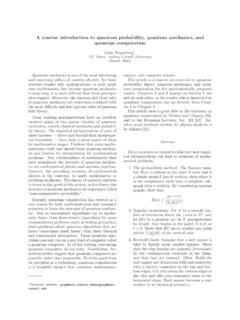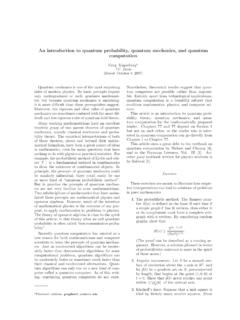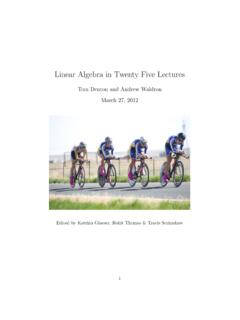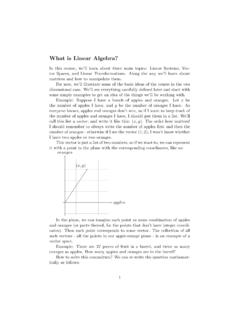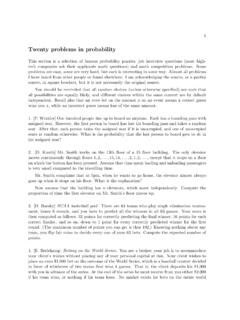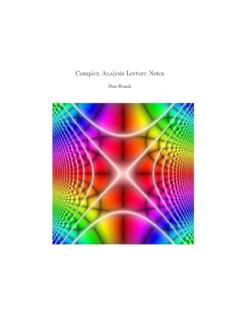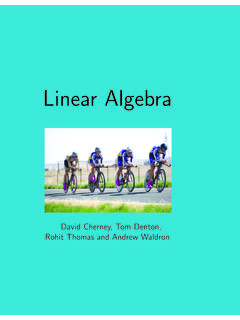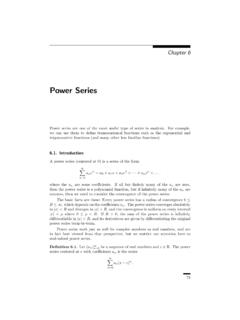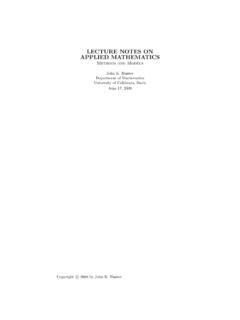Transcription of Topology of the Real Numbers - Mathematics Home
1 Chapter 5. Topology of the Real Numbers In this chapter, we define some topological properties of the real Numbers R and its subsets. Open sets Open sets are among the most important subsets of R. A collection of open sets is called a Topology , and any property (such as convergence, compactness, or con- tinuity) that can be defined entirely in terms of open sets is called a topological property. Definition A set G R is open if for every x G there exists a > 0 such that G (x , x + ). The entire set of real Numbers R is obviously open, and the empty set is open since it satisfies the definition vacuously (there is no x ). Example The open interval I = (0, 1) is open. If x I, then . x 1 x I (x , x + ) , = min , > 0. 2 2. Similarly, every finite or infinite open interval (a, b), ( , b), or (a, ) is open. Example The half-open interval J = (0, 1] isn't open, since 1 J and (1 , 1 + ) isn't a subset of J for any > 0, however small.)
2 The next proposition states a characteristic property of open sets. Proposition An arbitrary union of open sets is open, and a finite intersection of open sets is open. 89. 90 5. Topology of the Real Numbers S Suppose that {Ai R : i I} is an arbitrary collection of open sets. If Proof. x i I Ai , then x Ai for some i I. Since Ai is open, there is > 0 such that Ai (x , x + ), and therefore [. Ai (x , x + ), i I. S. which proves that i I Ai is open. Suppose Tn that {Ai R : i = 1, 2, .. , n} is a finite collection of open sets. If x i=1 Ai , then x Ai for every 1 i n. Since Ai is open, there is i > 0. such that Ai (x i , x + i ). Let = min{ 1 , 2 , .. , n } > 0. Then we see that n \. Ai (x , x + ), i=1. Tn which proves that i=1 Ai is open.. The previous proof fails for an infinite intersection of open sets, since we may have i > 0 for every i N but inf{ i : i N} = 0. Example The interval . 1 1. In = , n n is open for every n N, but.]
3 \. In = {0}. n=1. is not open. In fact, every open set in R is a countable union of disjoint open intervals, but we won't prove it here. Neighborhoods. Next, we introduce the notion of the neighborhood of a point, which often gives clearer, but equivalent, descriptions of topological concepts than ones that use open intervals. Definition A set U R is a neighborhood of a point x R if U (x , x + ). for some > 0. The open interval (x , x + ) is called a -neighborhood of x. A neighborhood of x needn't be an open interval about x, it just has to contain one. Some people require than a neighborhood is also an open set, but we don't;. we'll specify that a neighborhood is open if it's needed. Example If a < x < b, then the closed interval [a, b] is a neighborhood of x, since it contains the interval (x , x + ) for sufficiently small > 0. On the other hand, [a, b] is not a neighborhood of the endpoints a, b since no open interval about a or b is contained in [a, b].
4 We can restate the definition of open sets in terms of neighborhoods as follows. Open sets 91. Definition A set G R is open if every x G has a neighborhood U such that G U . In particular, an open set is itself a neighborhood of each of its points. We can restate Definition for the limit of a sequence in terms of neighbor- hoods as follows. Proposition A sequence (xn ) of real Numbers converges to a limit x R if and only if for every neighborhood U of x there exists N N such that xn U for all n > N . Proof. First suppose the condition in the proposition holds. Given > 0, let U = (x , x + ) be an -neighborhood of x. Then there exists N N such that xn U for all n > N , which means that |xn x| < . Thus, xn x as n . Conversely, suppose that xn x as n , and let U be a neighborhood of x. Then there exists > 0 such that U (x , x + ). Choose N N such that |xn x| < for all n > N . Then xn U for all n > N , which proves the condition.
5 Relatively open sets. We define relatively open sets by restricting open sets in R to a subset. Definition If A R then B A is relatively open in A, or open in A, if B = A G where G is open in R. Example Let A = [0, 1]. Then the half-open intervals (a, 1] and [0, b) are open in A for every 0 a < 1 and 0 < b 1, since (a, 1] = [0, 1] (a, 2), [0, b) = [0, 1] ( 1, b). and (a, 2), ( 1, b) are open in R. By contrast, neither (a, 1] nor [0, b) is open in R. The neighborhood definition of open sets generalizes to relatively open sets. First, we define relative neighborhoods in the obvious way. Definition If A R then a relative neighborhood in A of a point x A is a set V = A U where U is a neighborhood of x in R. As we show next, a set is relatively open if and only if it contains a relative neighborhood of every point. Proposition A set B A is relatively open in A if and only if every x B. has a relative neighborhood V in A such that B V.
6 Proof. Assume that B is open in A. Then B = A G where G is open in R. If x B, then x G, and since G is open, there is a neighborhood U of x in R such that G U . Then V = A U is a relative neighborhood of x with B V . Conversely, assume that every point x B has a relative neighborhood Vx =. A Ux in A such that Vx B, where Ux is a neighborhood of x in R. Since Ux is a neighborhood of x, it contains an open neighborhood Gx Ux . We claim that that B = A G where [. G= Gx . x B. 92 5. Topology of the Real Numbers It then follows that G is open, since it's a union of open sets, and therefore B = A G. is relatively open in A. To prove the claim, we show that B A G and B A G. First, B A G. since x A Gx A G for every x B. Second, A Gx A Ux B for every x B. Taking the union over x B, we get that A G B.. Closed sets Sets are not doors. (Attributed to James Munkres.). Closed sets are defined topologically as complements of open sets.]
7 Definition A set F R is closed if F c = {x R : x . / F } is open. Example The closed interval I = [0, 1] is closed since I c = ( , 0) (1, ). is a union of open intervals, and therefore it's open. Similarly, every finite or infinite closed interval [a, b], ( , b], or [a, ) is closed. The empty set and R are both open and closed; they're the only such sets. Most subsets of R are neither open nor closed (so, unlike doors, not open doesn't mean closed and not closed doesn't mean open ). Example The half-open interval I = (0, 1] isn't open because it doesn't contain any neighborhood of the right endpoint 1 I. Its complement I c = ( , 0] (1, ). isn't open either, since it doesn't contain any neighborhood of 0 I c . Thus, I isn't closed either. Example The set of rational Numbers Q R is neither open nor closed. It isn't open because every neighborhood of a rational number contains irrational Numbers , and its complement isn't open because every neighborhood of an irrational number contains rational Numbers .))
8 Closed sets can also be characterized in terms of sequences. Proposition A set F R is closed if and only if the limit of every convergent sequence in F belongs to F . Proof. First suppose that F is closed and (xn ) is a convergent sequence of points xn F such that xn x. Then every neighborhood of x contains points xn F . / F c , since F c is open and every y F c has a neighborhood It follows that x . c U F that contains no points in F . Therefore, x F . Conversely, suppose that the limit of every convergent sequence of points in F. belongs to F . Let x F c . Then x must have a neighborhood U F c ; otherwise for every n N there exists xn F such that xn (x 1/n, x + 1/n), so x = lim xn , and x is the limit of a sequence in F . Thus, F c is open and F is closed.. Closed sets 93. Example To verify that the closed interval [0, 1] is closed from Proposi- tion , suppose that (xn ) is a convergent sequence in [0, 1]. Then 0 xn 1 for all n N, and since limits preserve (non-strict) inequalities, we have 0 lim xn 1, n.
9 Meaning that the limit belongs to [0, 1]. On the other hand, the half-open interval I = (0, 1] isn't closed since, for example, (1/n) is a convergent sequence in I whose limit 0 doesn't belong to I. Closed sets have complementary properties to those of open sets stated in Proposition Proposition An arbitrary intersection of closed sets is closed, and a finite union of closed sets is closed. Proof. If {Fi : i I} is an arbitrary collection of closed sets, then every Fic is open. By De Morgan's laws in Proposition , we have !c \ [. Fi = Fic , i I i I. T. which is open by Proposition Thus i I Fi is closed. Similarly, the complement of a finite union of closed sets is open, since n !c n [ \. Fi = Fic , i=1 i=1. so a finite union of closed sets is closed.. The union of infinitely many closed sets needn't be closed. Example If In is the closed interval . 1 1. In = ,1 , n n then the union of the In is an open interval.)]
10 [. In = (0, 1). n=1. If A is a subset of R, it is useful to consider different ways in which a point x R can belong to A or be close to A. Definition Let A R be a subset of R. Then x R is: (1) an interior point of A if there exists > 0 such that A (x , x + );. (2) an isolated point of A if x A and there exists > 0 such that x is the only point in A that belongs to the interval (x , x + );. (3) a boundary point of A if for every > 0 the interval (x , x + ) contains points in A and points not in A;. (4) an accumulation point of A if for every > 0 the interval (x , x+ ) contains a point in A that is distinct from x. 94 5. Topology of the Real Numbers When the set A is understood from the context, we refer, for example, to an interior point.. Interior and isolated points of a set belong to the set, whereas boundary and accumulation points may or may not belong to the set. In the definition of a boundary point x, we allow the possibility that x itself is a point in A belonging to (x , x + ), but in the definition of an accumulation point, we consider only points in A belonging to (x , x + ) that are distinct from x.]

